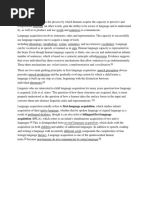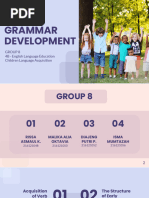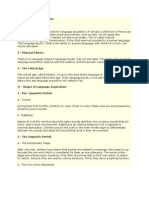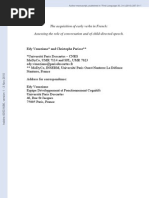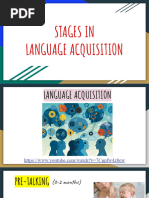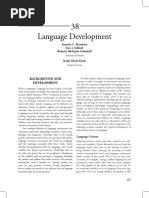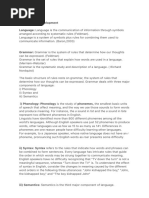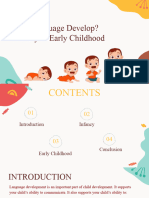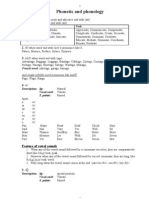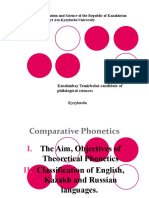One Word Utterances
One Word Utterances
Uploaded by
Thea NunungCopyright:
Available Formats
One Word Utterances
One Word Utterances
Uploaded by
Thea NunungCopyright
Available Formats
Share this document
Did you find this document useful?
Is this content inappropriate?
Copyright:
Available Formats
One Word Utterances
One Word Utterances
Uploaded by
Thea NunungCopyright:
Available Formats
One-Word Utterances
Once the combination of morphemes was no longer considered the criterion for the starting point of language, the origin began to be pushed back earlier and earlier. Single-word utterances became a new focus. Today there remains a strong interest in the study of the childs acquisition of word-meaning at this stage. Lets start with some definitions and descriptions:
When is a Word a Word?
When should we say that a child is using a real word? Researchers have applied criteria like the following: 1. The same utterance is used consistently to signal the same meaning (i.e., to name the same things) 2. It approximates the sound of the conventional word used by adults 3. It is spoken with the intention to communicate (not just in imitation of what an adult has just said) 4. It is used in a variety of settings, and to name items the child has not heard others naming. And distinctions have been drawn among: protowords: invented rather than words from the adult language, but seem to have consistent meaning -> context-bound words: used only in a single context -> real words: context-free; used to label categories rather than particular objects in a single context. Bloom videotaped kids and found that their expression of emotion changed when they uttered a word: they showed an inability to express emotion and talk at the same time (G & H-P, 105). Uttering a word takes effort.
The MacArthur Communication Development Inventory
This huge survey documented the types of words used by young children. Half the words used by toddlers are words for objects: top are foods and drinks, animals, body parts, clothing, toys and vehicles. Within the food category: 80 % of 16-24 m olds know apple & cheese.
Handout for Psy 598-02, summer 2001
Packer
One Word Utterances 2
Only 50 % of 24m know yogurt or raisin. Peoples names are frequent; so are action words (up, sit, see, eat, down, go) modifiers (hot, allgone, more), social words (thank you, no).
The Vocabulary Spurt
An adult knows around 50,000 words. By first grade a child knows 10,000; by fifth grade 50,000. Thats 5.5 new words a day from 18 months to 6 years of age. At about 18 months, once the child speaks around 40 words, vocabulary learning explodes, increasing from around 10 new words a month to around 30.
Overextension
The vocabulary spurt coincides with an increase in overextension or overgeneralization. This happens with about one third of a childs words, more often with familiar words than new ones. Most overextensions are categorical: dada for moma; truck for bus. Some overextensions are analogical: used for a perceptually similar object, not in the same category. Egg for apple. Others are relational: doll for crib. There is less overextension in comprehension (Where is the dog?) than in production.
The Phonology of One-Word Utterances
Nearly all initial words are monosyllabic CV or VC units, or CVCV constructions. Labial consonants (/p, b, m, w/) and alveolar consonants (/t, d/) are common, most often the plosives (/p, b, t, d, g, k/), along with some fricatives (/s, f/) and nasals (/m, n/). This illustrates that place of articulation tends to be acquired starting from the front of the mouth and moving to the back. It also illustrates that manner of articulation tends to be acquired from the most consonant-like to the least consonant-like. (Stops and nasals, which both require complete closure of the oral cavity, come before liquids and fricatives.) Children often substitute a glide (typically [w]) for a liquid. E.g. room will be pronounced as [wum]. And stops are often substituted for fricatives: [dt] for that. Vowel production varies a great deal, but the basic /a, i, u/ triangle is usually acquired early. This illustrates that extreme values in the vowel systemthose maximally distinct from one anothertend to be acquired first. It also illustrates that children acquire common sounds earlier: /a/ occurs in all languages, /i,u/ in most languages. Children avoid producing some words they clearly comprehend. They may produce only words containing specific sounds. But there is much individual variation in this.
Packer
One Word Utterances 3
Simplifying Phonological Strategies
When it comes to combining phonemes, children create strategies to simplify the job of articulating tricky phoneme combinations. These strategies tend to appear after 18 months. Before this, children tend simply to avoid words they find difficult. Common Phonological Strategies Strategy Repeating the initial consonant-vowel in a multisyllable word Deleting of unstressed syllables in a multisyllable word Replacing fricatives with stop consonants Replacing consonant sounds produced in the rear and palate area of the vocal tract with ones produced in the frontal area Replacing liquid sounds (l or r) with glides (j or w) Reducing consonant-vowel-consonant words to consonant-vowel form by deleting the final consonant Replacing an ending consonant syllable with a vowel Reducing a consonant cluster to a single consonant Examples TV becomes didi, cookie becomes gege. banana becomes nana, granola becomes nola, giraffe becomes raffe. sea becomes tea, say becomes tay, sing becomes ting. shoe becomes zue, shop becomes zop, goose becomes doose. lap becomes jap, ready becomes weddy. bib becomes bi, bike becomes bai, more becomes muh. apple becomes appo, bottom becomes bada. clown becomes cown, play becomes pay, train becomes tain.
Phonological Regression
Children may actually seem to lose their ability to pronounce particular sounds. For example, one child established the words down and stone as [dwn] and [don] (doan). Then, however, when he tried to say other words beginning with oral stops and ending with nasals, he produced them with nasals in both positions. For example, he produced beans as [minz] (means) and dance as [nns] (nance). After a few weeks this nasal assimilation began to take over the established forms for down and stone; soon he was saying [nwn] (noun) and [non] (noan). Another type of regression involves the apparent loss of the ability to say a sound in new words, while the sound is retained in the correct pronunciation of older words.
One-Word Utterances: Holophrastic or Not?
An issue that researchers have debated is whether a one-word utterance is properly understood as a holophrase or not. Those who view a single-word utterance as a holophrase generally understood this to mean that the utterance represents a sentence,
Packer
One Word Utterances 4
or implies a proposition, or stands for a complete thought. While the child may be capable only of uttering a single word, they are conceiving of something more complex. Among those who have argued in favor of the holophrase conception, some have argued that the correct approach is syntactic, others that it should be semantic.
A. A Syntax Approach to One-Word Utterances
A simple approach to the syntax of one-word utterances is to classify them as verbs, nouns, and so on, even though strictly speaking these terms have no significance outside the context of sentence structure. A more sophisticated approach sees not just syntactic categories but syntactic structure in childrens one-word utterances. David McNeill (1970) argued that children never utter mere labels; thats to say, children are not using one-word utterances simply to name, to refer to, things (or events) in their environment. The facts of language acquisition could not be as they are unless the concept of a sentence is available to children at the start of their learning. The concept of a sentence is the main guiding principle in a childs attempt to organize and interpret the linguistic evidence that fluent speakers make available to him.... Children everywhere begin with exactly the same initial hypothesis: sentences consist of single words. The entire structure of a sentence must be squeezed through this tiny space (p. 2). McNeill argued that grammatical relations gradually emerge during the one-word stage. Nouns are far more common than verbs, and they appear to be used as the objects of implied verbs (door, meaning close the door), as the objects of prepositions (eye, meaning water is in my eye), and as the subjects of sentences (baby, meaning the baby fell down). We would... expect two-word sentences when children decide to mention the verbs that go with objects or the nouns that go with modifiers. Children begin to produce two-word sentences when they adopt the requirement that grammatical relations be expressed overtly in speech (p. 60). This may seem odd, but McNeill was assuming that grammatical relations are logical relations. They are not relations of order. The lexical items derived from grammatical relations describe the logical connections between words, therefore, and not the order of words. The order of words in a sentence comes from a different source (p. 67). So McNeill considered holophrastic utterances to have a complete syntactic structure, even though only one constituent is expressed.
B. A Semantic Approach to One-Word Utterances
Another way to approach one-word utterances is in terms of what they seem to mean: thats to say, their semantic character. Again, two approaches are possible, looking at the semantics of the individual words, the other looking at the semantics of something more holistic. Weve seen this is tricky with two-word utterances; its an even more delicate matter with one-word utterances. For one thing, the semantics of early
Packer
One Word Utterances 5
utterances is very labile (Piaget writes of their disconcerting mobility). And because a one-word utterance relies so heavily on context (as well as paralinguistics such as gesture and intonation) sense and reference are highly inferential.
Ingram (1971) proposed that the structure representing what a child is saying with a one-word utterance must be a semantic one, rather than syntactic. Using Fillmores semantic case grammar, Ingram characterized holophrastic utterances with diagrams like the following: S Modality Proposition Transitivity Agent Act Predication Object State
Only one constituent of this structure is expressed as a word, Ingram proposed. The other constituents may be expressed by gesture, crying, and so on. Patricia Greenfield also viewed one-word utterances as holophrastic. But she emphasized the role of context, rather than accompanying action. Words are being inserted into... a cognitive-perceptual-action framework from the outset, so that the researchers semantic characterization of an utterance must include a description of this (perceived) context. Weve seen that Lois Bloom, in her 1970 research on two-word utterances, considered a semantic characterization a necessary first step towards the goal of writing a Chomskian grammar of a childs speech. The idea was that the child omits material that is, nonetheless, implied in what they say, and that this material needs to be inferred by the researcher, through rich interpretation, so it can be properly included in the linguistic description of the utterance and the grammar of the childs speech. But in her 1973 One Word at a Time, where she studied single word utterances rather than word combinations, Bloom argued against the notion that single word speech is holophrastic. She insisted that there is evidence against the idea that structure is hidden behind the actual word spoken, and proposed instead that at this stage of language acquisition children develop certain conceptual representations of regularly recurring experiences, and then learn whatever words conveniently code such conceptual notions (p. 113). Bloom identified the following semantic notions in one-word utterances: General Relationship Word Function/Meaning
Packer
One Word Utterances 6
Existence
there uh-oh more away
Recurrence Disappearance
Nonexistence
A gone no
Cessation Rejection Action Location
stop no up up
To point out objects To point out objects, particularly those that startled First to request and later to comment on the recurrence of an activity or object To comment on the disappearance of object which had existed in context. Same as above. To comment on nonexistence where existence had been expected To comment on the cessation of an activity To protest undesired action or comment on forbidden object (e.g. stove) To request the action of being picked up To comment on spatial location.
C. A Pragmatic Approach to One-Word Utterances
A third approach is to focus on the pragmatics of the one-word stage, and see childs utterances in terms of speech acts. The article by Michael Halliday describes an analysis that Halliday himself calls sociosemantic, but seems more accurately described as pragmatic. And John Dore (1975) categorized the primitive speech acts of the one-word stage:
Packer
One Word Utterances 7
But often the assumption has been that children use single-word utterances to name things in the world around them: i.e., to refer.
How Do Children Learn Words?
How does a child learn the words she uses at this stage? A variety of mechanisms of learning words have been proposed. However, the common assumption has been that when a child learns a new word she is learning its referent.
A. Fast Mapping.
One set of explanations for childrens ability to learn words suggests that there are innate principles or assumptions which make the task feasible. These principles enable very quick, one-trial, learning, in which novel names are attributed to unfamiliar objects. This is called fast mapping, the mapping being the forging of a link between word and world. Specifically, it is suggested that young children assume that: - new words label whole objects, not their parts or properties, or spatial relations or actions (the whole object assumption);
Packer
One Word Utterances 8
- new labels should be extended to items taxonomically related to the original item, rather than those thematically related (e.g. bones & people; babies & bottles) (the taxonomic assumption); - objects have only one name (the mutual exclusivity assumption). Sometimes these assumptions may contradict one another, but that is useful, since any one of them alone would produce inaccurate word-learning. This list of assumptions has grown so large that recently Golinkoff et al (1994) have proposed a two-tier model with six principles, to bring some organization to this kind of theory: First Tier (childs assumptions around 12 months): 1. Reference: words map objects, actions, and attributes 2. Extendibility: words label more than original referent 3. Object Scope: words map to whole objects Second Tier (childs assumptions at time of vocabulary spurt): 4. Conventionality: speakers in the community prefer specific agreed upon terms 5. Categorical Scope: words are extended based on category, not perceptual similarity 6. Novel Name-Nameless Category: novel names map to unnamed categories
B. Syntactic cues
Its been suggested that around age 2y children start to become able to use cues in the syntax of a sentence to identify new words and learn them.
C. Social-Pragmatic Explanations
Another kind of explanation emphasizes that child learn language in a social nexus, guided by adults who are linguistic expert. The child is offered pragmatic cues that render the cognitive assumptions listed above unnecessary. Katherine Nelson has argued that Quines problem of reference (remember Gavagai) is not an issue for children; they dont have to guess the reference of a word, because the adults around them are constantly guessing what the child is referring to! Lois Bloom talks of the Principle of relevance: In a typical word-learning situation, infant and adult exploit their mutual signals of ostensive-inferential communication to share a focus of attention and the most likely candidate for what a word means (1993, p. 86) A number of researchers have proposed that around the time of the vocabulary spurt, children have now learned to follow the social cues of adultsmonitoring referential
Packer
One Word Utterances 9
cues, and success of their communicative efforts (cf. Baldwins research). In addition children around this age have begun reasoning about peoples intentions.
D. All of the Above
A recent suggestion is that an emergentist coalition model is necessary, that allows that all these factors probably play a role (Hollich et al, 2000).
Explanations of Over-Extension
Several explanations have been offered for the phenomenon of overextension: (1) the childs definitions for these early words are incomplete, (2) there are gaps in the childs lexicon and she uses words she knows to fill these gaps, (3) the child has problems retrieving the appropriate word. Eve Clark has employed the linguistic notion that all word meaning can be analyzed in terms of a universal set of semantic features, such as animate/inanimate, human/nonhuman. These features correspond to perceivable attributes in the environment: attributes such as size, shape, color. Clark suggested that the childs definition of doggie might include semantic features such as four legs, fur, tail, barks. When the child encounters a new animal in the environment, he must check its features to see whether or not they are appropriate for him to apply the label doggie. At first the childs definitions will use only a few features. As the child develops he will add more features and delete inappropriate ones. Overextensions occur when a child infers category membership from a partial match of features. For example, a moose has four legs, fur and a tail; a child has to learn that antlers are a disqualifying attribute for application of the label doggie.
From One-Word Utterances to Non-Verbal Communication
Once one-word utterances have been examined not just in semantic terms but now in pragmatic terms, the origin of language gets pushed back again. For gestures and nonverbal vocalizations (i.e. sounds but no words) can have pragmatic force too, though arguably no semantics (no referential capacity). Weve find Halliday locating the origin of learning how to mean at around 9 months of age. And well see next week that Elizabeth Bates too finds 9 months the time when performatives prior to speech appear. And that leads to the question of what the cognitive and social precursors of language are.
Communication in Deaf Children
Packer
One Word Utterances 10
A study of deaf infants of hearing, but non-signing, parents found they invented spontaneous home signs of two kinds: Indicators (such as pointing) referred to people, objects and places. Characterizing signs referred to actions and object properties: e.g., holding the fist to the mouth and making chewing motion = eat. Holding index finger and thumb in the shape of a circle = round. Acredolo & Goodwyn have found hearing children inventing signs too, and recommend communicating with preverbal infants this way. They have found verbal language accelerated by this. Note that these baby signs are unlike sign language: the latter is conventionalized and includes grammatical rules. Bloom, L. (1970). Language development: Form and function in emerging grammars. Cambridge, MA: MIT Press. Bloom, L. (1973). One word at a time: The use of single-word utterances before syntax. The Hague: Mouton. Bloom, L. (1998). Language acquisition in its developmental context. In D. Kuhn & R. Siegler (Eds.), Handbook of Child Psychology. Volume 2: Cognition, Perception and Language, (5 ed., Vol. 2, pp. 309-370). New York: Wiley. Dore, J. (1975). Holophrases, speech acts and language universals. Journal of Child Language, 2(1), 33-. Halliday, M. A. K. (1975). Learning how to mean. In E. H. Lenneberg & E. Lenneberg (Eds.), Foundations of language development: A multidisciplinary approach (Vol. 1, pp. 239-265). New York: Basic Books. Halliday, M. A. K. (1975). Learning how to mean. London: Edward Arnold. Hollich, G. J., Hirsh-Pasek, K., & Golinkoff, R. M. (2000). Breaking the language barrier: An emergentist coalition model for the origins of word learning. Monographs of thr Society for Research in Child Development, 65(3, whole issue). McNeill, D. (1970). The acquisition of language: the study of developmental psycholinguistics. New York: Harper & Row. Nelson, K. (1973). Structure and strategy in learning to talk. Monographs of the Society for Research in Child Development, 38(149, whole number). Scollon, R. (1976). Conversations with a one year old: A case study of the developmental foundation of syntax: The University Press of Hawaii. Scollon, R. (1979). A real early stage: An unzippered condensation of a dissertation on child language. In E. Ochs & B. B. Schieffelin (Eds.), Developmental pragmatics (pp. 215-227). New York: Academic Press.
You might also like
- Scheme-of-Work-for-Preschool-to-Nursery 2Document155 pagesScheme-of-Work-for-Preschool-to-Nursery 2Precious Emechebe100% (5)
- Malagasy - Janie Rasoloson - Carl RubinoDocument44 pagesMalagasy - Janie Rasoloson - Carl RubinounfoNo ratings yet
- Hamann's Aesthetica in NuceDocument43 pagesHamann's Aesthetica in Nucekgallagher_8100% (1)
- Syntactic DevelopmentDocument11 pagesSyntactic DevelopmentXhéhzÂda saleem zehriNo ratings yet
- Children's Production Abilities Lag Behind Their Comprehension Abilities Throughout Language DevelopmentDocument8 pagesChildren's Production Abilities Lag Behind Their Comprehension Abilities Throughout Language DevelopmentDijana JakovacNo ratings yet
- Elt200.written Report. JpangcogaDocument8 pagesElt200.written Report. JpangcogaAlyanah PantaoNo ratings yet
- Précis of How Children Learn The Meaning of Words - Paul BloomDocument40 pagesPrécis of How Children Learn The Meaning of Words - Paul BloomGrazie_bNo ratings yet
- Theories of Language Development: July 2017Document6 pagesTheories of Language Development: July 2017Wafaa Reda FahimNo ratings yet
- 505 Short NotesDocument17 pages505 Short NotesFsn PlzaNo ratings yet
- Semantics:: ParaphraseDocument7 pagesSemantics:: ParaphraseEdward AlbolerasNo ratings yet
- How Children Learn LanguageDocument8 pagesHow Children Learn LanguageFakhruRozyNo ratings yet
- I - 1.3.2. Question Formotions: Other ProblemsDocument5 pagesI - 1.3.2. Question Formotions: Other ProblemsZano ElfNo ratings yet
- CD Module 5Document37 pagesCD Module 5Sulaikha JaanNo ratings yet
- 01-Language AcquisitionDocument32 pages01-Language Acquisition8hdx48b8rdNo ratings yet
- Syntactic Development in ChildrenDocument5 pagesSyntactic Development in ChildrenAndhy Andha Dhyan HardhyantiNo ratings yet
- Language Acquisition Is The Process by Which Humans Acquire The Capacity To Perceive andDocument8 pagesLanguage Acquisition Is The Process by Which Humans Acquire The Capacity To Perceive andnurhuda1229No ratings yet
- Casasola Language DevelopDocument3 pagesCasasola Language DevelopotiliaglamNo ratings yet
- WRITTEN REPORT ECE10 1 Final2Document20 pagesWRITTEN REPORT ECE10 1 Final2Arcelyn Mendoza ArganaNo ratings yet
- Child Development LanguagesDocument3 pagesChild Development LanguagesjohnNo ratings yet
- English Language KS5 Vocabulary Master Booklet Child Language Acquisition SpeechDocument10 pagesEnglish Language KS5 Vocabulary Master Booklet Child Language Acquisition SpeechСофья ГроусNo ratings yet
- Child Language AcquisitionDocument5 pagesChild Language AcquisitionNidal ShahNo ratings yet
- Group 8 - Grammar DevelopmnentDocument21 pagesGroup 8 - Grammar DevelopmnentAnindita Salma NabilaNo ratings yet
- 10-Language AcquisitionDocument19 pages10-Language Acquisitionapi-462590765No ratings yet
- First Language AcquisitionDocument32 pagesFirst Language AcquisitionAyoub ChaterNo ratings yet
- Theories of Language Development: January 2017Document6 pagesTheories of Language Development: January 2017Abi RamiNo ratings yet
- Summary: First Language LearningDocument3 pagesSummary: First Language LearningPutri LeatariNo ratings yet
- Stages of First Lang AcquisitionDocument10 pagesStages of First Lang AcquisitionKaye Payot-OmapasNo ratings yet
- CHILD DEVELOPMENT -5Document13 pagesCHILD DEVELOPMENT -5Taniya T ThomasNo ratings yet
- 2010 17 VenezianoParisseFinalDocument43 pages2010 17 VenezianoParisseFinalssr.lingNo ratings yet
- Semantic Acquisition DraftDocument29 pagesSemantic Acquisition DraftTirti RayNo ratings yet
- The Four Components of LanguageDocument5 pagesThe Four Components of LanguageEffendy WijayaNo ratings yet
- Child Language AcquisitionDocument5 pagesChild Language AcquisitionJanice ScottNo ratings yet
- Language AcquisitionDocument19 pagesLanguage Acquisitionherbert mourenNo ratings yet
- How Children Learn LanguageDocument20 pagesHow Children Learn LanguageZeineb AyachiNo ratings yet
- Language DevelopmentDocument23 pagesLanguage DevelopmentRaquel AsensioNo ratings yet
- 3 - Lexical-Semantic DevelopmentDocument28 pages3 - Lexical-Semantic DevelopmentMarya Fanta C LupuNo ratings yet
- Week 2Document20 pagesWeek 2Lucy ThomasNo ratings yet
- Stages in Language AcquisitionDocument38 pagesStages in Language AcquisitionJessika EscobedoNo ratings yet
- Phonological and Lexical DevelopmentDocument12 pagesPhonological and Lexical DevelopmentMinigirlNo ratings yet
- 9 - LanguageDocument30 pages9 - LanguageM. UzairNo ratings yet
- Article Critique On Statistical LearningDocument9 pagesArticle Critique On Statistical LearningJaveria KhawarNo ratings yet
- English Communication and CompositionDocument6 pagesEnglish Communication and CompositionRocky100% (1)
- REPORT-IN-LING-215-SSUES-IN-L1-AND-L2 AcquisitionDocument3 pagesREPORT-IN-LING-215-SSUES-IN-L1-AND-L2 AcquisitionKris LabiosNo ratings yet
- Speech Production and ComprehensionDocument4 pagesSpeech Production and ComprehensionHaDIL Gaidi officielNo ratings yet
- Child - Language - Development - Kel 5 (1) - 1Document13 pagesChild - Language - Development - Kel 5 (1) - 1Jihan nafisa20No ratings yet
- Language DevelopmentDocument16 pagesLanguage DevelopmentKatlego MdluliNo ratings yet
- Acquiring Language Written ReportDocument15 pagesAcquiring Language Written ReportPrincessIldefonsoNo ratings yet
- Lexical and Semantic Dev 2024Document3 pagesLexical and Semantic Dev 2024Jawad AfzalNo ratings yet
- Language NoteDocument5 pagesLanguage Notehasnahenazarin4278No ratings yet
- The Development of Syntax and Morphology 2Document81 pagesThe Development of Syntax and Morphology 2Irv ManthaNo ratings yet
- The Logical Problem of Language Acquisition: April 2002Document53 pagesThe Logical Problem of Language Acquisition: April 2002Stefanny NiviaNo ratings yet
- Developmental Psychology Unit3 Language Dev.Document6 pagesDevelopmental Psychology Unit3 Language Dev.coclegendth14No ratings yet
- 16826-Article Text-42895-1-10-20230510 (1) (1)Document9 pages16826-Article Text-42895-1-10-20230510 (1) (1)tesfayekefyalewNo ratings yet
- Methodology of Teaching EnglishDocument103 pagesMethodology of Teaching EnglishDANUSH KNo ratings yet
- Psycho Chapter IIDocument7 pagesPsycho Chapter IIHelmi AndriawanNo ratings yet
- Chapter 12 - L201B - Growing Up With EnglishDocument41 pagesChapter 12 - L201B - Growing Up With EnglishghazidaveNo ratings yet
- Wa0021.Document24 pagesWa0021.Chithra SureshNo ratings yet
- Parts of SpeechDocument11 pagesParts of SpeechAyesha AsifNo ratings yet
- Language Acquisition TheoryDocument2 pagesLanguage Acquisition TheoryCherry Lyn Aguilar FranciscoNo ratings yet
- Lexical Development Explosion of WordsDocument68 pagesLexical Development Explosion of WordsNo NoyNo ratings yet
- Compound Noun ThesisDocument6 pagesCompound Noun Thesisaliciabrooksbeaumont100% (2)
- ENG 150 Module15 ReportDocument23 pagesENG 150 Module15 Reportabadiergab75No ratings yet
- Phonology IIDocument4 pagesPhonology IIAbdelkarim BouhNo ratings yet
- Antasari Voice Articulator Exercises To English Song PronunciationDocument105 pagesAntasari Voice Articulator Exercises To English Song PronunciationMaulana AhmadNo ratings yet
- Spelling RulesDocument3 pagesSpelling RulesSufla AhujaNo ratings yet
- The International Phonetic Alphabet.... Prof..Msaddek PDFDocument3 pagesThe International Phonetic Alphabet.... Prof..Msaddek PDFabdoapple477No ratings yet
- Reasoning ModuleDocument64 pagesReasoning ModuleNAND KISHOR GUPTANo ratings yet
- Immediate Download Phonological Typology 1st Edition Matthew K. Gordon Ebooks 2024Document52 pagesImmediate Download Phonological Typology 1st Edition Matthew K. Gordon Ebooks 2024chomzyxheis100% (3)
- E-Content Submission To INFLIBNETDocument10 pagesE-Content Submission To INFLIBNETkushiNo ratings yet
- College of Education: International School of Asia and The PacificDocument5 pagesCollege of Education: International School of Asia and The PacificSharmaineJoseNo ratings yet
- Handbook of Phonetic AlphabetDocument264 pagesHandbook of Phonetic Alphabettenderrest100% (3)
- Фонетика Тест 1-4Document1 pageФонетика Тест 1-4Карина КамаловаNo ratings yet
- Httprepository Unp Ac id201881LENI20MARLINA-1 PDFDocument59 pagesHttprepository Unp Ac id201881LENI20MARLINA-1 PDFyjmvdjsdr5No ratings yet
- Phonotic and PhonologyDocument3 pagesPhonotic and PhonologyMohammad HalimNo ratings yet
- Vowels and Consonants MOD 2Document6 pagesVowels and Consonants MOD 2Devika SNo ratings yet
- 1. PHONETICS AND PHONOLOGY (Tập bài giảng)Document71 pages1. PHONETICS AND PHONOLOGY (Tập bài giảng)Maii PhươngNo ratings yet
- Bài Kt 2 Ngữ Âm HọcDocument20 pagesBài Kt 2 Ngữ Âm HọcLệ ThứcNo ratings yet
- Connected SpeechDocument12 pagesConnected SpeechHenry MaierNo ratings yet
- Theoretical Phonetics PPT 08.09.2021Document21 pagesTheoretical Phonetics PPT 08.09.2021BagzhanNo ratings yet
- تعاريف وملخصات الصوتDocument12 pagesتعاريف وملخصات الصوتAhmed FalahNo ratings yet
- Ministry of Education, Science, Vocational Training and Early Education Curriculum Development CentreDocument49 pagesMinistry of Education, Science, Vocational Training and Early Education Curriculum Development CentreTahpehs Phiri100% (1)
- Noun Derivation in LutirikiDocument74 pagesNoun Derivation in LutirikiBryan Birama0% (1)
- LKG Syllabus 2022-23 NewDocument1 pageLKG Syllabus 2022-23 NewgauravNo ratings yet
- English 2 Q2 Week 6Document37 pagesEnglish 2 Q2 Week 6Lynette VillapandoNo ratings yet
- Decoding Practice Unit 1Document94 pagesDecoding Practice Unit 1maryam layeeqNo ratings yet
- Reasoning E-Book (ENGLISH) for Railway ExamsDocument498 pagesReasoning E-Book (ENGLISH) for Railway Examspyar singhNo ratings yet
- An Handbook On Audio Cassette Course in Kashmiri PDFDocument113 pagesAn Handbook On Audio Cassette Course in Kashmiri PDFPradhyumna Srivatsa HNo ratings yet
- Ipn Ejercicio LinkingDocument2 pagesIpn Ejercicio LinkingLuis Felipe Perez HernandezNo ratings yet
- First Grade Spelling Rules PDFDocument4 pagesFirst Grade Spelling Rules PDFmonicatindall100% (1)















